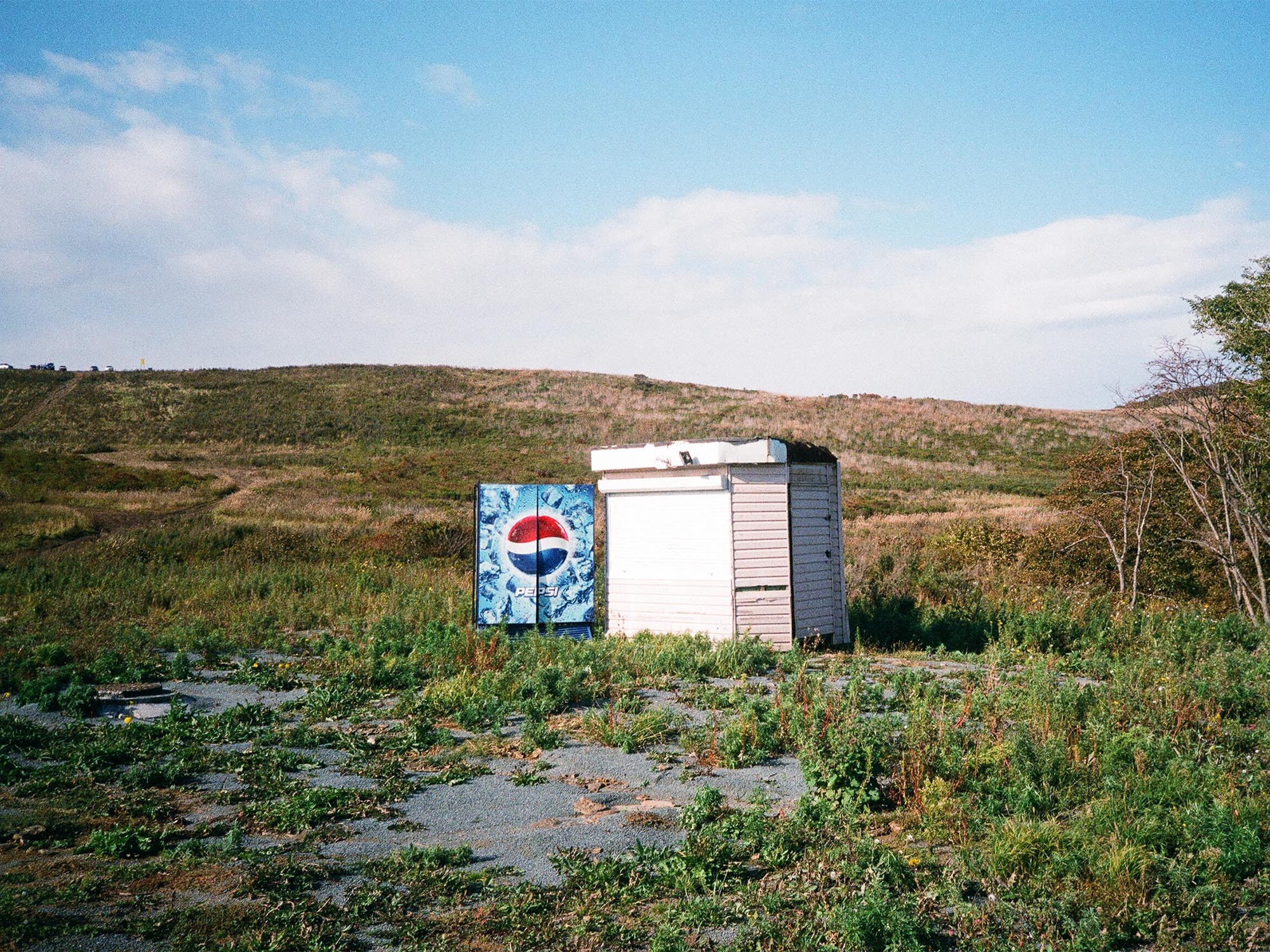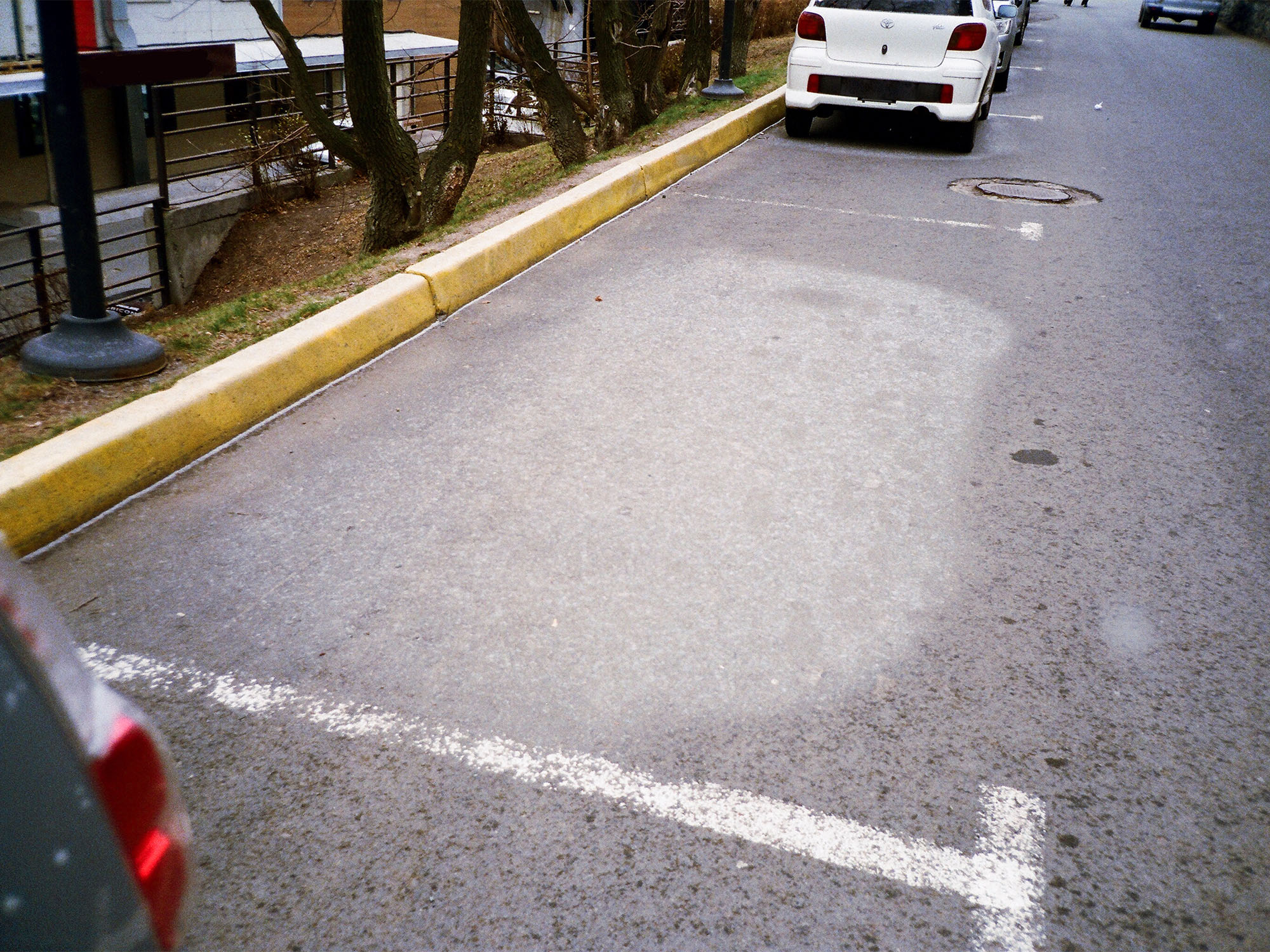
On March 23, the ZARYA Center for Contemporary Art will launch “Sum of its Parts,” an exhibition by the Vladivostok-based photographer Denis Korobov. The show is conceived of as an installation of 60 photographs of varying size and scale, reflecting the everyday life of Vladivostok. The exhibition will remain on view through April 22. Admission is free of charge.
“I started taking my first shots of the city back in 2014,” Denis Korobov recalls. “These compositions were caught by chance in the camera’s viewfinder, but each wielded a mystical aesthetic, whether it was the specific geometry of a building, the rainbow-tinged film of gasoline in a puddle, or a dead pigeon. As time passed, I came to understand that I was not interested so much by photographs of people, as by images of what they leave behind. These collisions of ideas, textures, geometries – this is what I look around for as I cut circles through the city’s residential districts.”
Over the past three years, Korobov has documented the daily life of the city in short but numerous series, including “garage façades,” “the art of advertising,” “car parks,” “under a blue tarp,” “food and the body,” and “playgrounds.” His images provide a fresh and unusual perspective on moments that we might otherwise consider random or invisible to the normal eye, and thus capable of slipping by without notice.
Through the artist’s interpretation, the portrait of the city comes together as a combination of images, the sum of individual parts bound by the light irony of the observer, a compositional ingenuity, a refined sense of color and a poetic use of rhythm, all while producing a documentary record of the light, character and texture of a given place. And while several of the images may suggest partial staging, they still preserve the elusive quality of the moment.
As the curator of the exhibition, Larisa Grinberg, explains, “In the case of Denis Korobov, what we are seeing is his search for the genius loci, exploring the environment around him. His method of research – conducted through scouring minute, almost unidentifiable segments – is entirely logical. On the other hand, close attention to non-obvious details is not exactly a novel technique for any generation of photographers. However, this is precisely where a new round of young photographers picks up: just because ‘everything has already been said,’ it doesn’t mean that someone has already lived our lives, and everything we are experiencing in the here and now, we are experiencing for the first time. It’s like with a declaration of love; every second, thousands of people all over the planet are making them, but that doesn’t mean that one can’t still express one’s sincerity through this act of confession. In the same way, these ‘parts of the city’ that Korobov is documenting are each meaningful in their own way. And the search for the whole, the genius loci, through these barely-legible fragments stands alone as an exploration of what’s happened not ‘before our time,’ but rather ‘never before our time.’”
For the exhibition “Sum of its Parts,” the photographs are presented without frames and directly mounted on the wall in a manner that downplays their individual significance in favor of emphasizing their role within the greater context, allowing the viewer to forge their own associations.
For Reference: Denis Korobov is a photographer born in 1991 in the Primorsky Krai settlement of Terney. He currently lives and works in Vladivostok. Among his solo exhibitions are “No Parking No Parking,” at the ZARYA Art Residency in 2017, as well as an exhibition at Ogurtsy (“Cucumbers”) space in Vladivostok in 2015. He has participated in the apartment exhibitions of the Vladivostok School of Contemporary Art (VSCA) and the auction preview exhibitions at ZARYA CCA in 2016 and 2017. Korobov was included in VSCA’s 2016 project “New Poverty,” created in collaboration with Moscow’s Krasnyi Center and the St. Petersburg-based collective Chto Delat.
Larisa Grinberg is a gallerist, curator, and chief specialist in regional development for ROSIZO/NCCA, as well as the chair of the Masters program in “Art-Management and Gallery Business” in the department of “The History of Film and Contemporary Art” at the Russian State University for the Humanities. Since 2007, she has been the co-founder and art-director of the photography gallery Grinberg (formerly known as “Photographer.ru”) and she also co-founded the Moscow-based photography agency, Photographer.ru (2004-2014). From 2014-2017, she was the curator of three municipal exhibition halls: Na Shabolovke, Peresvetov Pereulok and Gallery Nagornaya.

NOVEMBER 4 / 5PM / SCREENING HALL
A new participant of the program at ZARYA AiR is a photographer from Vladivostok Denis Korobov, who already will hold a welcoming lecture this Saturday.
The lecture will be focused on the Denis’s path of becoming a photographer and the process of his professional development, as well as the technical features of his work. Also, Denis will share some examples of the world leading photography that stylistically close to his art. During his stay at ZARYA AiR, Denis is planning to explore the theme of a spontaneous parking system in the city, thereby raising a problem of the transport infrastructure

16 ДЕКАБРЯ 2017 — 4 ЯНВАРЯ 2018
ВЕРНИСАЖ: 16 ДЕКАБРЯ / 17:00
Участник программы арт-резиденции «Заря» из Владивостока представит выставку, посвященную городским парковкам
16 декабря в 17:00 в Мастерской арт-резиденции «Заря» пройдет вернисаж выставки «Машины не машины ставить не ставить» фотографа Дениса Коробова. Экспозиция будет открыта до 4 января. Вход свободный. Для посещения необходимо обратиться на ресепшен.
Тема особых взаимоотношений между владивостокцами и их личными транспортными средствами регулярно поднимается в течение последних десятилетий, когда проблема отсутствия подходящей инфраструктуры при всеобщей доступности автомобилей стала очевидной. Как хорошо известно каждому местному жителю, парковка захватывает любое доступное место – мы видим ее из окон, проходим вдоль нее по тротуару, ежедневно отвоевывая пространство для собственного передвижения. Владивосток в его сегодняшнем состоянии – город водителей, машин и их стоянок.
В проекте «Машины не машины ставить не ставить» владивостокский фотограф и участник программы арт-резиденции «Заря» Денис Коробов представляет свой взгляд на это явление. Название выставки, поначалу кажущееся абсурдным, отсылает в растиражированному в интернете фото неизвестного автора, где на металлических воротах именно в такой формулировке обозначен запрет парковаться, и формулировка эта так же спонтанна и двойственна, как и регулирование автостоянок в целом.
Коробов не получил специального фотографического образования и ищет свой визуальный язык самостоятельно, опираясь на примеры близких мировых авторов. Он работает сериями – так, среди них есть циклы, посвященные вывескам, уличной рекламе, детским площадкам, которые, с одной стороны, типизируют эти явления, с другой, выявляют незаметные глазу обывателя детали.
Парковки, на которых фокусируется резидентский проект Коробова, имеют совершенно разный характер – они могут быть регулярными, нелегальными, стихийными, заполонившими пространство, вдоль дорог, перпендикулярно друг другу, как элементы пятнашек или другой настольной игры. В части работ не появляется сам образ автомобиля, но указывается на его присутствие – многочисленные ограждения, объявления и надписи на уличных поверхностях говорят о связанных с транспортом проблемах куда более красноречиво. Владивосток предстает без прикрас, неустроенным и нерегулярным, с хаотично расставленными бетонными блоками и покрышками, призванными имитировать благоустройство, с бесконечными трещинами в асфальте. Кульминацией становится транспортный коллапс первого снега, когда собравшаяся накануне пробка не двигалась до первых рассветных часов – и вся дорога стала одной большой парковкой.
Однако в то же время на эти явления фотограф смотрит без оценки, с присущей ему мягкой иронией. В глазах фотографа стоянки предстают дополнительной частью городской инфраструктуры: архитектура представляет собой ее статичный слой, а парковки – подвижный, который каждый раз складывается заново и создает новую структуру лабиринта. Недостаток свободного пространства, неудобство маршрута (и пешеходного, и автомобильного), вызываемые постоянными изменениями в этом подвижном слое неизбежно влияют на наше восприятие городской среды в целом – но, возможно, и они в том числе является источником той внутренней динамичности и гибкости, свойственным как самому городу, так и характеру его обитателей.
*Денис Коробов родился в 1991 году в пос. Терней Приморского края, в настоящее время живет и работает во Владивостоке. Денис документирует облик постсоветского города, каковым является Владивосток, выявляя характерные для него детали и противоречия. Также он часто обращается к жанру портретной фотографии. Представлял свою персональную экспозицию в пространстве «Огурцы» (Владивосток, 2015 г.). Участник квартирных выставок Владивостокской школы современного искусства (ВШСИ) и предаукционной выставки в ЦСИ «Заря» в 2016 г. Представлял работы в рамках проекта «Новая бедность» ВШСИ (совместно с центром «Красный», Москва и арт-группой «Что делать?», Санкт-Петербург), 2016 г.